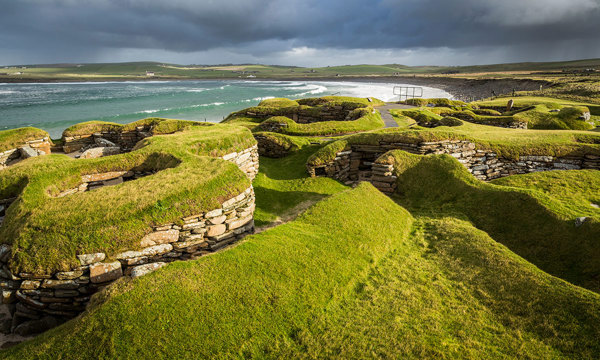The Climate Vulnerability Index (CVI) assessment for the Heart of Neolithic Orkney World Heritage site will be presented to participants at the 43rd session of the World Heritage Committee currently taking place in Baku, Azerbaijan.
The report was produced following a workshop in Orkney earlier this year to trial the Climate Vulnerability Index (CVI) framework, which assesses the threat that climate change poses to all types of heritage sites. Supported by Historic Environment Scotland (HES), in partnership with University of the Highlands and Islands, James Cook University (JCU, Australia), Orkney Islands Council, the Union of Concerned Scientists (UCS) and ICOMOS Climate Change and Heritage Working Group, the workshop was attended by leading international heritage professionals and climate scientists.
The CVI approach examined both the vulnerability of the Outstanding Universal Value (OUV) of the Orkney World Heritage site – the basis for its selection as a World Heritage site – as well as community vulnerability, which explored the economic, social and cultural importance of the site for the local community and the potential impact of any loss, as well as its resilience to climate change risks.
The Heart of Neolithic Orkney was the first cultural World Heritage site to undergo CVI assessment, following an initial trial of the tool at Shark Bay in Western Australia – a natural site which encompasses 2.2 million hectares of diverse landscapes, animals and plant life.
The report recommends wider application of the CVI methodology, both in Scotland and internationally, highlighting its significant potential to enhance understanding and support adaptation to address climate change challenges at World Heritage sites worldwide.
Ewan Hyslop, Head of Technical Research and Science at HES, said:
"It was a great honour for the Heart of Neolithic Orkney World Heritage site to be chosen to pilot the CVI methodology, and we’re pleased to now bring those findings to the international stage during the World Heritage Committee meeting.
While the findings of the report reiterate the severity of climate change risk to the World Heritage site in Orkney, there are also positives to take away in terms of the resilience of the site and the wider community to manage the impacts of climate change in the future.
"It’s heartening that work undertaken in Scotland could have such a significant positive impact for heritage sites sites across the world, and we hope that the World Heritage Committee will recommend that the CVI is adopted as a standard for measuring climate change risk to World Heritage sites."
Scott Heron, Co-Lead Developer of the CVI from JCU, said:
"The workshop ranked the vulnerability for the Orkney World Heritage site at the highest level, with greatest risk from precipitation change, sea level change and storm intensity and frequency"
The potential impacts on the community associated with the property were assessed as 'high', but the strong capacity for adaptation within the economic, social and cultural structures mitigated the community vulnerability, demonstrating the overall resilience of the locality to climate change.
Adam Markham, Deputy Director of the Climate and Energy Program at UCS and a co-developer of the CVI said:
Climate change is the fastest growing threat to World Heritage sites.
"Sites worldwide are being damaged and degraded by melting glaciers, rising seas, intensifying weather events, worsening droughts and longer wildfire seasons, yet there is no standardized way to assess vulnerability. The CVI is being developed to fill that gap, so that experts and site managers can use local knowledge and the best available science to determine the risk level, and then take the appropriate action to protect them."
It is hoped that CVI assessment will be rolled out to all of Scotland’s World Heritage sites in the future, including St Kilda and the Antonine Wall.
Download the CVI assessmentAbout Historic Environment Scotland (HES)
- We are the lead public body charged with caring for, protecting and promoting the historic environment. We will lead on delivering Scotland’s first strategy for the historic environment, Our Place in Time.
- Historic Scotland, Scran, Canmore, The National Collection of Aerial Photography (NCAP), The Engine Shed, Stirling Castle and Edinburgh Castle are sub-brands of HES.
- View our press pack and keep up to date by registering for media release email alerts. If you wish to unsubscribe, please contact us.
Follow Historic Environment Scotland
Twitter: @HistEnvScot | @welovehistory
Facebook: @HistoricEnvScotland | @VisitHistoricScotland
Instagram: @HistEnvScot | @historicscotland
For further information, please contact:
Stacey Dent
Historic Environment Scotland Media Office
Direct line: 0131 668 8097
Mobile: 07557 489 322
communications@hes.scot

